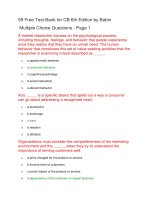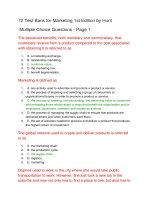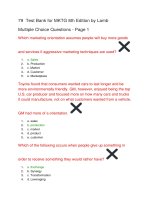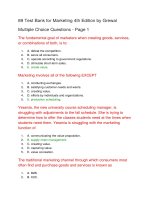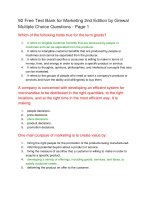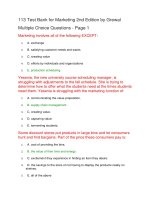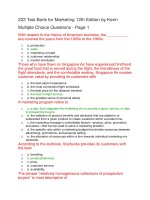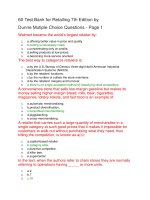Test bank for principles of pediatric nursing caring for children 5th edition by ball
Bạn đang xem bản rút gọn của tài liệu. Xem và tải ngay bản đầy đủ của tài liệu tại đây (79.98 KB, 14 trang )
Full file at />
Ball/Bindler/Cowen, Principles of Pediatric Nursing: Caring for Children 5th
Edition Test Bank
Chapter 1
Question 1
Type: MCSA
Using a family-centered approach, pediatric nursing focuses on protecting children from newborn through young
adulthood. Which of the following is not considered a nursing role in caring for children and their families?
1. Advocacy.
2. Case management.
3. Patient education.
4. Researcher.
Correct Answer: 4
Rationale 1: A researcher is not involved in the family-centered approach to patient care of children and their
families. Advocacy, case management, and patient education are all roles directly involved in the care of children
and their families.
Rationale 2: A researcher is not involved in the family-centered approach to patient care of children and their
families. Advocacy, case management, and patient education are all roles directly involved in the care of children
and their families.
Rationale 3: A researcher is not involved in the family-centered approach to patient care of children and their
families. Advocacy, case management, and patient education are all roles directly involved in the care of children
and their families.
Rationale 4: A researcher is not involved in the family-centered approach to patient care of children and their
families. Advocacy, case management, and patient education are all roles directly involved in the care of children
and their families.
Global Rationale:
Cognitive Level: Analyzing
Client Need: Safe Effective Care Environment
Client Need Sub:
Nursing/Integrated Concepts: Nursing Process: Assessment
Learning Outcome: LO 02. Describe the roles of nurses in child health care.
Question 2
Type: MCMA
buy this full document at
Full file at />
A nurse is working with pediatric clients in a research facility. The nurse recognizes that federal guidelines are in
place that delineate which pediatrics clients must give assent for participation in research trials. Based upon the
client’s age, the nurse would seek assent from which children?
Standard Text: Select all that apply.
1. The precocious 4-year-old starting as a cystic fibrosis research-study participant.
2. The 7-year-old leukemia client electing to receive a newly developed medication, now being researched.
3. The 10-year-old starting in an investigative study for clients with precocious puberty.
4. The 13-year-old client beginning participation in a research program for ADHD treatments.
Correct Answer: 2,3,4
Rationale 1: Federal guidelines mandate that research participants 7 years old and older must receive
developmentally appropriate information about health-care procedures and treatments and give assent.
Rationale 2: Federal guidelines mandate that research participants 7 years old and older must receive
developmentally appropriate information about health-care procedures and treatments and give assent.
Rationale 3: Federal guidelines mandate that research participants 7 years old and older must receive
developmentally appropriate information about health-care procedures and treatments and give assent.
Rationale 4: Federal guidelines mandate that research participants 7 years old and older must receive
developmentally appropriate information about health-care procedures and treatments and give assent.
Global Rationale:
Cognitive Level: Applying
Client Need: Psychosocial Integrity
Client Need Sub:
Nursing/Integrated Concepts: Nursing Process: Planning
Learning Outcome: LO 06. Examine three unique pediatric legal and ethical issues in pediatric nursing practice.
Question 3
Type: MCSA
The nurse in a pediatric acute-care unit is assigned the following tasks. Based on recognition that the action
defined requires training beyond the preparation of a registered nurse, the nurse would refuse to:
1. Diagnose an 8-year-old with acute otitis media and prescribe an antibiotic.
2. Listen to the concerns of an adolescent about being out of school for a lengthy surgical recovery.
3. Provide information to a mother of a newly diagnosed 4-year-old diabetic about local support-group options.
buy this full document at
Full file at />
4. Diagnose a 6-year-old with Diversional Activity Deficit related to placement in isolation.
Correct Answer: 1
Rationale 1: The role of the pediatric nurse includes providing nursing assessment, direct nursing care
interventions, client and family education at developmentally appropriate levels, client advocacy, case
management, minimization of distress, and enhancement of coping. Advanced practice nurse practitioners
perform assessment, diagnosis, and management of health conditions.
Rationale 2: The role of the pediatric nurse includes providing nursing assessment, direct nursing care
interventions, client and family education at developmentally appropriate levels, client advocacy, case
management, minimization of distress, and enhancement of coping. Advanced practice nurse practitioners
perform assessment, diagnosis, and management of health conditions.
Rationale 3: The role of the pediatric nurse includes providing nursing assessment, direct nursing care
interventions, client and family education at developmentally appropriate levels, client advocacy, case
management, minimization of distress, and enhancement of coping. Advanced practice nurse practitioners
perform assessment, diagnosis, and management of health conditions.
Rationale 4: The role of the pediatric nurse includes providing nursing assessment, direct nursing care
interventions, client and family education at developmentally appropriate levels, client advocacy, case
management, minimization of distress, and enhancement of coping. Advanced practice nurse practitioners
perform assessment, diagnosis, and management of health conditions.
Global Rationale:
Cognitive Level: Applying
Client Need: Health Promotion and Maintenance
Client Need Sub:
Nursing/Integrated Concepts: Nursing Process: Implementation
Learning Outcome: LO 02. Describe the roles of nurses in child health care.
Question 4
Type: MCSA
A 7-year-old child has been admitted for acute appendicitis. The parents are questioning the nurse about
expectations during the child’s recovery. Which information tool would be most useful in answering a parent’s
questions about the timing of key events?
1. Healthy People 2020.
2. Clinical pathways.
3. Child mortality statistics.
4. National clinical practice guidelines.
Correct Answer: 2
buy this full document at
Full file at />
Rationale 1: Clinical pathways are interdisciplinary documents provided by a hospital to suggest ideal sequencing
and timing of events and interventions for specific diseases to improve efficiency of care and enhance recovery.
This pathway serves as a model outlining the typical hospital stay for individuals with specified conditions.
Healthy People 2020 contains objectives set by the U.S. government to improve the health and reduce the
incidence of death in the twenty-first century. Child mortality statistics can be compared with those from other
decades for the evaluation of achievement toward health-care goals. National clinical practice guidelines promote
uniformity in care for specific disease conditions by suggesting expected outcomes from specific interventions.
Rationale 2: Clinical pathways are interdisciplinary documents provided by a hospital to suggest ideal sequencing
and timing of events and interventions for specific diseases to improve efficiency of care and enhance recovery.
This pathway serves as a model outlining the typical hospital stay for individuals with specified conditions.
Healthy People 2020 contains objectives set by the U.S. government to improve the health and reduce the
incidence of death in the twenty-first century. Child mortality statistics can be compared with those from other
decades for the evaluation of achievement toward health-care goals. National clinical practice guidelines promote
uniformity in care for specific disease conditions by suggesting expected outcomes from specific interventions.
Rationale 3: Clinical pathways are interdisciplinary documents provided by a hospital to suggest ideal sequencing
and timing of events and interventions for specific diseases to improve efficiency of care and enhance recovery.
This pathway serves as a model outlining the typical hospital stay for individuals with specified conditions.
Healthy People 2020 contains objectives set by the U.S. government to improve the health and reduce the
incidence of death in the twenty-first century. Child mortality statistics can be compared with those from other
decades for the evaluation of achievement toward health-care goals. National clinical practice guidelines promote
uniformity in care for specific disease conditions by suggesting expected outcomes from specific interventions.
Rationale 4: Clinical pathways are interdisciplinary documents provided by a hospital to suggest ideal sequencing
and timing of events and interventions for specific diseases to improve efficiency of care and enhance recovery.
This pathway serves as a model outlining the typical hospital stay for individuals with specified conditions.
Healthy People 2020 contains objectives set by the U.S. government to improve the health and reduce the
incidence of death in the twenty-first century. Child mortality statistics can be compared with those from other
decades for the evaluation of achievement toward health-care goals. National clinical practice guidelines promote
uniformity in care for specific disease conditions by suggesting expected outcomes from specific interventions.
Global Rationale:
Cognitive Level: Analyzing
Client Need: Psychosocial Integrity
Client Need Sub:
Nursing/Integrated Concepts: Nursing Process: Planning
Learning Outcome: LO 01. Describe the continuum of pediatric health care.
Question 5
Type: MCSA
The nurse recognizes that the pediatric client is from a cultural background different from that of the hospital
staff. The nurse identifies this as a potential problem and sets a nursing goal to:
1. Overlook or minimize the differences that exist.
2. Facilitate the family’s ability to comply with the care needed.
buy this full document at
Full file at />
3. Avoid inadvertently offending the family by imposing the nurse’s perspective.
4. Encourage complementary beneficial cultural practices as primary therapies.
Correct Answer: 2
Rationale 1: The incorporation of the family’s cultural perspective into the care plan is most likely to result in the
family’s ability to accept medical care and comply with the regimen prescribed. Since culture develops from
social learning, attempts to ignore or minimize cultural consideration will result in mistrust, suspicion, or offenses
that can have negative effects upon the health of children by reducing the resources available to promote health
and prevent illness. Complementary therapy may be used later if other primary therapies prove to be ineffective.
Rationale 2: The incorporation of the family’s cultural perspective into the care plan is most likely to result in the
family’s ability to accept medical care and comply with the regimen prescribed. Since culture develops from
social learning, attempts to ignore or minimize cultural consideration will result in mistrust, suspicion, or offenses
that can have negative effects upon the health of children by reducing the resources available to promote health
and prevent illness. Complementary therapy may be used later if other primary therapies prove to be ineffective.
Rationale 3: The incorporation of the family’s cultural perspective into the care plan is most likely to result in the
family’s ability to accept medical care and comply with the regimen prescribed. Since culture develops from
social learning, attempts to ignore or minimize cultural consideration will result in mistrust, suspicion, or offenses
that can have negative effects upon the health of children by reducing the resources available to promote health
and prevent illness. Complementary therapy may be used later if other primary therapies prove to be ineffective.
Rationale 4: The incorporation of the family’s cultural perspective into the care plan is most likely to result in the
family’s ability to accept medical care and comply with the regimen prescribed. Since culture develops from
social learning, attempts to ignore or minimize cultural consideration will result in mistrust, suspicion, or offenses
that can have negative effects upon the health of children by reducing the resources available to promote health
and prevent illness. Complementary therapy may be used later if other primary therapies prove to be ineffective.
Global Rationale:
Cognitive Level: Analyzing
Client Need: Health Promotion and Maintenance
Client Need Sub:
Nursing/Integrated Concepts: Nursing Process: Planning
Learning Outcome: LO 03. Analyze the current societal influences on pediatric health care and nursing practice.
Question 6
Type: MCSA
The telephone triage nurse at a pediatric clinic knows each call is important. However, recognizing that infant
deaths are most frequent in this group, the nurse must be extra attentive during the call from the parent of an
infant who is:
1. Less than 3 weeks old.
2. Of an American Indian family.
buy this full document at
Full file at />
3. Of a non-Hispanic black family.
4. Between 6 months old and 8 months old.
Correct Answer: 1
Rationale 1: Almost two-thirds of all infant deaths occur during the first 28 days after birth. During 2000, the
infant mortality statistics for non-Hispanic blacks were 13.6 per 100,000 live births and for American Indian and
Alaskan Natives were 8.3 per 100,000 live births.
Rationale 2: Almost two-thirds of all infant deaths occur during the first 28 days after birth. During 2000, the
infant mortality statistics for non-Hispanic blacks were 13.6 per 100,000 live births and for American Indian and
Alaskan Natives were 8.3 per 100,000 live births.
Rationale 3: Almost two-thirds of all infant deaths occur during the first 28 days after birth. During 2000, the
infant mortality statistics for non-Hispanic blacks were 13.6 per 100,000 live births and for American Indian and
Alaskan Natives were 8.3 per 100,000 live births.
Rationale 4: Almost two-thirds of all infant deaths occur during the first 28 days after birth. During 2000, the
infant mortality statistics for non-Hispanic blacks were 13.6 per 100,000 live births and for American Indian and
Alaskan Natives were 8.3 per 100,000 live births.
Global Rationale:
Cognitive Level: Applying
Client Need: Health Promotion and Maintenance
Client Need Sub:
Nursing/Integrated Concepts: Nursing Process: Planning
Learning Outcome: LO 04. Report the most common causes of child mortality and reasons for hospitalization by
age group.
Question 7
Type: MCSA
Despite the availability of State Children’s Health Insurance Programs (SCHIP), many eligible children are not
enrolled. The nursing intervention that can best help eligible children to become enrolled is:
1. Assessment of the details of the family’s income and expenditures.
2. Case management to limit costly, unnecessary duplication of services.
3. To advocate for the child by encouraging the family to investigate its SCHIP eligibility.
4. To educate the family about the need for keeping regular well-child-visit appointments.
Correct Answer: 3
Rationale 1: In the role of an advocate, a nurse will advance the interests of another; by suggesting the family
investigate its SCHIP eligibility, the nurse is directing their action toward the child’s best interest. Financial
buy this full document at
Full file at />
assessment is more commonly the function of a social worker. The case-management activity mentioned will not
provide a source of funding nor will the educational effort described.
Rationale 2: In the role of an advocate, a nurse will advance the interests of another; by suggesting the family
investigate its SCHIP eligibility, the nurse is directing their action toward the child’s best interest. Financial
assessment is more commonly the function of a social worker. The case-management activity mentioned will not
provide a source of funding nor will the educational effort described.
Rationale 3: In the role of an advocate, a nurse will advance the interests of another; by suggesting the family
investigate its SCHIP eligibility, the nurse is directing his action toward the child’s best interest. Financial
assessment is more commonly the function of a social worker. The case-management activity mentioned will not
provide a source of funding nor will the educational effort described.
Rationale 4: In the role of an advocate, a nurse will advance the interests of another; by suggesting the family
investigate its SCHIP eligibility, the nurse is directing their action toward the child’s best interest. Financial
assessment is more commonly the function of a social worker. The case-management activity mentioned will not
provide a source of funding nor will the educational effort described.
Global Rationale:
Cognitive Level: Analyzing
Client Need: Health Promotion and Maintenance
Client Need Sub:
Nursing/Integrated Concepts: Nursing Process: Planning
Learning Outcome: LO 02. Describe the roles of nurses in child health care.
Question 8
Type: MCSA
A supervisor is reviewing the documentation of the nurses in the unit. The documentation that most accurately and
correctly contains all the required parts for a narrative entry is the entry that reads
1. “2/2/05 1630 Catheterized using an 8 French catheter, 45 ml clear yellow urine obtained, specimen sent to lab,
squirmed and cried softly during insertion of catheter. Quiet in mother’s arms following catheter removal. M. May
RN”
2. “1/9/05 2 pm NG tube placement confirmed and irrigated with 30 ml sterile water. Suction set at low,
intermittent. Oxygen via nasal canal at 2 L/min. Nares patent, pink, and nonirritated. K. Earnst RN”
3. “4:00 Trach dressing removed with dime-size stain of dry serous exudate. Site cleansed with normal saline.
Dried with sterile gauze. New sterile trach sponge and trach ties applied. Respirations regular and even throughout
the procedure. F. Luck RN”
4. “Feb. ’05 Port-A-Cath assessed with Huber needle. Blood return present. Flushed with NaCl sol., IV gamma
globins hung and infusing at 30cc/hr. Child smiling and playful throughout the procedure. P. Potter, RN”
Correct Answer: 1
buy this full document at
Full file at />
Rationale 1: The client record should include the date and time of entry, nursing care provided, assessments, an
objective report of the client’s physiologic response, exact quotes, and the nurse’s signature and title.
Rationale 2: The client record should include the date and time of entry, nursing care provided, assessments, an
objective report of the client’s physiologic response, exact quotes, and the nurse’s signature and title.
Rationale 3: The client record should include the date and time of entry, nursing care provided, assessments, an
objective report of the client’s physiologic response, exact quotes, and the nurse’s signature and title.
Rationale 4: The client record should include the date and time of entry, nursing care provided, assessments, an
objective report of the client’s physiologic response, exact quotes, and the nurse’s signature and title.
Global Rationale:
Cognitive Level: Applying
Client Need: Safe Effective Care Environment
Client Need Sub:
Nursing/Integrated Concepts: Nursing Process: Assessment
Learning Outcome: LO 02. Describe the roles of nurses in child health care.
Question 9
Type: MCSA
A 12-year-old pediatric client is in need of surgery. The health-care member who is legally responsible for
obtaining informed consent for an invasive procedure is the:
1. Nurse.
2. Physician.
3. Unit secretary.
4. Social worker.
Correct Answer: 2
Rationale 1: Informed consent is legal preauthorization for an invasive procedure. It is the physician’s legal
responsibility to obtain this, because it consists of an explanation about the medical condition, a detailed
description of treatment plans, the expected benefits and risks related to the proposed treatment plan, alternative
treatment options, the client’s questions, and the guardian’s right to refuse treatment.
Rationale 2: Informed consent is legal preauthorization for an invasive procedure. It is the physician’s legal
responsibility to obtain this, because it consists of an explanation about the medical condition, a detailed
description of treatment plans, the expected benefits and risks related to the proposed treatment plan, alternative
treatment options, the client’s questions, and the guardian’s right to refuse treatment.
Rationale 3: Informed consent is legal preauthorization for an invasive procedure. It is the physician’s legal
responsibility to obtain this, because it consists of an explanation about the medical condition, a detailed
buy this full document at
Full file at />
description of treatment plans, the expected benefits and risks related to the proposed treatment plan, alternative
treatment options, the client’s questions, and the guardian’s right to refuse treatment.
Rationale 4: Informed consent is legal preauthorization for an invasive procedure. It is the physician’s legal
responsibility to obtain this, because it consists of an explanation about the medical condition, a detailed
description of treatment plans, the expected benefits and risks related to the proposed treatment plan, alternative
treatment options, the client’s questions, and the guardian’s right to refuse treatment.
Global Rationale:
Cognitive Level: Applying
Client Need: Safe Effective Care Environment
Client Need Sub:
Nursing/Integrated Concepts: Nursing Process: Planning
Learning Outcome: LO 05. Contrast the policies for obtaining informed consent of minors to policies for adults.
Question 10
Type: MCSA
A child is being prepared for an invasive procedure. The mother of the child has legal custody but is not present.
After details of the procedure are explained, the legal informed consent for treatment on behalf of a minor child
will be obtained from:
1. The divorced parent without custody.
2. A cohabitating unmarried boyfriend of the child’s mother.
3. A grandparent who lives in the home with the child.
4. A babysitter with written proxy consent.
Correct Answer: 4
Rationale 1: A parent may grant proxy consent in writing to another adult so that children are not denied
necessary health care. In the case of divorced parents, the parent with custody may be the only parent allowed by
some states to give informed consent. Residence in the same household with a child does not authorize an adult to
sign consent for treatment.
Rationale 2: A parent may grant proxy consent in writing to another adult so that children are not denied
necessary health care. In the case of divorced parents, the parent with custody may be the only parent allowed by
some states to give informed consent. Residence in the same household with a child does not authorize an adult to
sign consent for treatment.
Rationale 3: A parent may grant proxy consent in writing to another adult so that children are not denied
necessary health care. In the case of divorced parents, the parent with custody may be the only parent allowed by
some states to give informed consent. Residence in the same household with a child does not authorize an adult to
sign consent for treatment.
buy this full document at
Full file at />
Rationale 4: A parent may grant proxy consent in writing to another adult so that children are not denied
necessary health care. In the case of divorced parents, the parent with custody may be the only parent allowed by
some states to give informed consent. Residence in the same household with a child does not authorize an adult to
sign consent for treatment.
Global Rationale:
Cognitive Level: Applying
Client Need: Safe Effective Care Environment
Client Need Sub:
Nursing/Integrated Concepts: Nursing Process: Planning
Learning Outcome: LO 05. Contrast the policies for obtaining informed consent of minors to policies for adults.
Question 11
Type: MCSA
A 12-year-old child is being admitted to the unit for a surgical procedure. The child is accompanied by two
parents and a younger sibling. The level of involvement in treatment decision making for this child is:
1. That of an emancipated minor.
2. That of a mature minor.
3. That of assent.
4. None.
Correct Answer: 3
Rationale 1: Assent requires the ability to generally understand what procedure and treatments are planned, to
understand what participation is required, and to make a statement of agreement or disagreement with the plan.
Usually, in Piaget’s stage of formal operations, 11- to 13-year-olds should be able to problem solve using abstract
concepts and are able to give valid assent when parents sign the informed consent. An emancipated minor is a
self-supporting adolescent who is not subject to the control of a parent or guardian. A mature minor is a 14- or 15year-old whom the state law designates as being able to understand medical risks and who is thus permitted to
give informed consent for treatment.
Rationale 2: Assent requires the ability to generally understand what procedure and treatments are planned, to
understand what participation is required, and to make a statement of agreement or disagreement with the plan.
Usually, in Piaget’s stage of formal operations, 11- to 13-year-olds should be able to problem solve using abstract
concepts and are able to give valid assent when parents sign the informed consent. An emancipated minor is a
self-supporting adolescent who is not subject to the control of a parent or guardian. A mature minor is a 14- or 15year-old whom the state law designates as being able to understand medical risks and who is thus permitted to
give informed consent for treatment.
Rationale 3: Assent requires the ability to generally understand what procedure and treatments are planned, to
understand what participation is required, and to make a statement of agreement or disagreement with the plan.
Usually, in Piaget’s stage of formal operations, 11- to 13-year-olds should be able to problem solve using abstract
concepts and are able to give valid assent when parents sign the informed consent. An emancipated minor is a
buy this full document at
Full file at />
self-supporting adolescent who is not subject to the control of a parent or guardian. A mature minor is a 14- or 15year-old whom the state law designates as being able to understand medical risks and who is thus permitted to
give informed consent for treatment.
Rationale 4: Assent requires the ability to generally understand what procedure and treatments are planned, to
understand what participation is required, and to make a statement of agreement or disagreement with the plan.
Usually, in Piaget’s stage of formal operations, 11- to 13-year-olds should be able to problem solve using abstract
concepts and are able to give valid assent when parents sign the informed consent. An emancipated minor is a
self-supporting adolescent who is not subject to the control of a parent or guardian. A mature minor is a 14- or 15year-old whom the state law designates as being able to understand medical risks and who is thus permitted to
give informed consent for treatment.
Global Rationale:
Cognitive Level: Applying
Client Need: Safe Effective Care Environment
Client Need Sub:
Nursing/Integrated Concepts: Nursing Process: Planning
Learning Outcome: LO 05. Contrast the policies for obtaining informed consent of minors to policies for adults.
Question 12
Type: MCSA
The role of a nurse involved in pediatric education would include:
1. Giving primary care for high-risk children who are in hospital settings.
2. Giving primary care for healthy children.
3. Working toward the goal of informed choices with the family.
4. Obtaining a physician consultation for any technical procedures at delivery.
Correct Answer: 3
Rationale 1: The educator works with the family toward the goal of making informed choices through education
and explanation.
Rationale 2: The educator works with the family toward the goal of making informed choices through education
and explanation.
Rationale 3: The educator works with the family toward the goal of making informed choices through education
and explanation.
Rationale 4: The educator works with the family toward the goal of making informed choices through education
and explanation.
Global Rationale:
buy this full document at
Full file at />
Cognitive Level: Applying
Client Need: Safe Effective Care Environment
Client Need Sub:
Nursing/Integrated Concepts: Nursing Process: Planning
Learning Outcome: LO 02. Describe the roles of nurses in child health care.
Question 13
Type: MCSA
The pediatric nurse’s best defense against an accusation of malpractice or negligence is that the nurse:
1. Followed the physician’s written orders.
2. Met the scope and standards of practice for pediatric nursing.
3. Is a nurse practitioner or clinical nurse specialist.
4. Was acting on the advice of the nurse manager.
Correct Answer: 2
Rationale 1: Meeting the scope and standards of practice for pediatric nursing would cover the pediatric nurse
against an accusation of malpractice or negligence because the standards are rigorous and cover all bases of
excellent nursing practice. Following the physician’s written orders or acting on the advice of the nurse manager
are not enough to defend the nurse from accusations because the orders and/or advice may be wrong or unethical.
Being a clinical nurse specialist or nurse practitioner does not defend the nurse against these accusations if she
does not follow the Society of Pediatric Nurses standards of practice.
Rationale 2: Meeting the scope and standards of practice for pediatric nursing would cover the pediatric nurse
against an accusation of malpractice or negligence because the standards are rigorous and cover all bases of
excellent nursing practice. Following the physician’s written orders or acting on the advice of the nurse manager
are not enough to defend the nurse from accusations because the orders and/or advice may be wrong or unethical.
Being a clinical nurse specialist or nurse practitioner does not defend the nurse against these accusations if she
does not follow the Society of Pediatric Nurses standards of practice.
Rationale 3: Meeting the scope and standards of practice for pediatric nursing would cover the pediatric nurse
against an accusation of malpractice or negligence because the standards are rigorous and cover all bases of
excellent nursing practice. Following the physician’s written orders or acting on the advice of the nurse manager
are not enough to defend the nurse from accusations because the orders and/or advice may be wrong or unethical.
Being a clinical nurse specialist or nurse practitioner does not defend the nurse against these accusations if she
does not follow the Society of Pediatric Nurses standards of practice.
Rationale 4: Meeting the scope and standards of practice for pediatric nursing would cover the pediatric nurse
against an accusation of malpractice or negligence because the standards are rigorous and cover all bases of
excellent nursing practice. Following the physician’s written orders or acting on the advice of the nurse manager
are not enough to defend the nurse from accusations because the orders and/or advice may be wrong or unethical.
Being a clinical nurse specialist or nurse practitioner does not defend the nurse against these accusations if she
does not follow the Society of Pediatric Nurses standards of practice.
buy this full document at
Full file at />
Global Rationale:
Cognitive Level: Applying
Client Need: Safe Effective Care Environment
Client Need Sub:
Nursing/Integrated Concepts: Nursing Process: Planning
Learning Outcome: LO 06. Examine three unique pediatric legal and ethical issues in pediatric nursing practice.
Question 14
Type: MCSA
A nurse who tells family members the condition of a newborn baby without first consulting the parents would be
considered to have committed:
1. A breach of privacy.
2. Negligence.
3. Malpractice.
4. A breach of ethics.
Correct Answer: 1
Rationale 1: A breach of privacy would have been committed in this situation, because it violates the right to
privacy of this family. The right to privacy is the right of a person to keep his person and property free from public
scrutiny (even other family members). Negligence and malpractice are punishable legal offenses and are more
serious. A breach of ethics would not apply to this situation.
Rationale 2: A breach of privacy would have been committed in this situation, because it violates the right to
privacy of this family. The right to privacy is the right of a person to keep his person and property free from public
scrutiny (even other family members). Negligence and malpractice are punishable legal offenses and are more
serious. A breach of ethics would not apply to this situation.
Rationale 3: A breach of privacy would have been committed in this situation, because it violates the right to
privacy of this family. The right to privacy is the right of a person to keep his person and property free from public
scrutiny (even other family members). Negligence and malpractice are punishable legal offenses and are more
serious. A breach of ethics would not apply to this situation.
Rationale 4: A breach of privacy would have been committed in this situation, because it violates the right to
privacy of this family. The right to privacy is the right of a person to keep his person and property free from public
scrutiny (even other family members). Negligence and malpractice are punishable legal offenses and are more
serious. A breach of ethics would not apply to this situation.
Global Rationale:
Cognitive Level: Applying
Client Need: Safe Effective Care Environment
Client Need Sub:
buy this full document at
Full file at />
Nursing/Integrated Concepts: Nursing Process: Implementation
Learning Outcome: LO 06. Examine three unique pediatric legal and ethical issues in pediatric nursing practice.
Question 15
Type: MCSA
Pediatric nurses have foundational knowledge learned in nursing school, and add specific competencies related to
the pediatric patient. Which of the following would be considered an additional specific expected competency of
the pediatric nurse?
1. Physical assessment.
2. Anatomical and developmental differences.
3. Nursing process.
4. Management of healthcare conditions.
Correct Answer: 2
Rationale 1: Assessing anatomical and developmental differences would be a specific expected competency for
the pediatric nurse that would not be learned in nursing school. Physical assessment, nursing process, and
management of health conditions are all foundational knowledge learned in nursing school.
Rationale 2: Assessing anatomical and developmental differences would be a specific expected competency for
the pediatric nurse that would not be learned in nursing school. Physical assessment, nursing process, and
management of health conditions are all foundational knowledge learned in nursing school.
Rationale 3: Assessing anatomical and developmental differences would be a specific expected competency for
the pediatric nurse that would not be learned in nursing school. Physical assessment, nursing process, and
management of health conditions are all foundational knowledge learned in nursing school.
Rationale 4: Assessing anatomical and developmental differences would be a specific expected competency for
the pediatric nurse that would not be learned in nursing school. Physical assessment, nursing process, and
management of health conditions are all foundational knowledge learned in nursing school.
Global Rationale:
Cognitive Level: Analyzing
Client Need: Safe Effective Care Environment
Client Need Sub:
Nursing/Integrated Concepts: Nursing Process: Assessment
Learning Outcome: LO 02. Describe the roles of nurses in child health care.
buy this full document at
